Luna and Shell GameChanger Innovate New Underground Sensor
Luna Innovations has developed a new concept with Shell’s GameChanger™ early-stage-technologies program to measure in-situ stresses in subsurface rock using Luna fiber optic sensing solutions.
The new concept, a Continuous Horizontal In-situ Stress Logger (CHISL), uses Luna’s ODiSI® product to get direct, high-resolution strain measurements of induced micro-fractures and borehole deformation. New algorithms then process the strain measurements at the borehole to estimate in-situ maximum and minimum horizontal stress and their orientations.
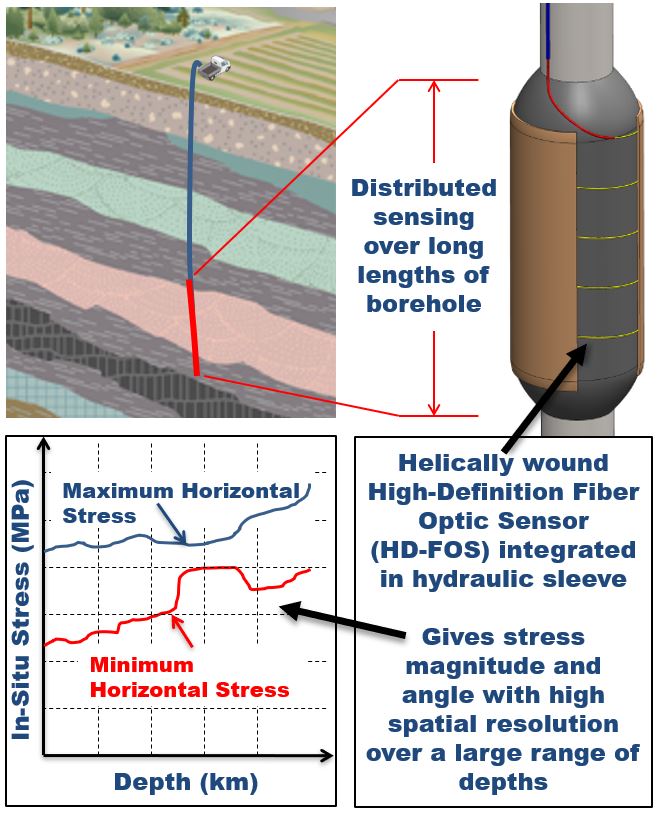
Why does this matter? Businesses that rely on underground operations, like the petroleum and geothermal industries, must have accurate estimates of in-situ stress (which is the existing pressure underground before a hole is drilled). This affects drilling, surveying, and fluid injection (hydraulic fracturing, water flooding, CO2 sequestration) as well as phenomena such as fault re-activation and induced seismicity.
What does industry think? “The reliable stress estimate is critical for many applications in oil and gas industry. For example, the success of hydraulic fracturing in shales strongly depends on the created fracture height, which in turn is strongly controlled by the stress variations with depth. Luna’s technology would allow to characterize stress depth profiles with unprecedented resolution, very relevant to hydraulic fracturing process,” commented by Alexei Savitski, Geomechanics Subject Matter Expert of Shell. “Today there is no access to such critical information. The maximum horizontal stress is one of the most uncertain subsurface properties. It is inferred from other data. But CHISL would allow to significantly reduce this uncertainty, which is critical for assessing the risks of fault re-activation and induced seismicity”.
“Working with Luna on this technology fits very well with the GameChanger mandate,” explains Haiyong Cai, the GameChanger sponsor for this project. “The program supports Luna to derisk the early development of this novel stress-measurement technology to the proof-of-concept level. It also engages Shell to put forward use cases where accurate, reliable stress measurements may drastically improve the bottom line.”
What makes Luna’s CHISL sensor unique? It integrates fiber optic sensors into a flexible hydraulic sleeve, which applies pressure to a borehole wall until small longitudinal fractures are formed. Unlike hydraulic fracturing, where fluid flows into the fractures and causes them to grow in length away from the borehole, CHISL does not allow the fluid to flow into the induced fractures. The CHISL sensor will provide new kinds of data that can be used to increase safety, production efficiency and optimization of future subsurface engineered systems. Future field operations using a ruggedized sensor could provide measurements for unprecedented lengths of boreholes and in less time than traditional hydraulic-fracturing techniques. Apart from the stress profiling of rock formations for planning of hydraulic fracturing, other applications include caprock integrity sensing for oil wells and optimized drilling of complex oil wells.
Explanation of the CHISL Sensing Technique (Patent Pending)
Embedding HD-FOS sensing fiber in a helical pattern allows for precise measurement of radial and axial strain as the hydraulic pressure inside the sleeve is increased. The continuous measurement of strain around the circumference and down the depth of the hole provides new types of data that have previously been unavailable, such as fracture initiation and evolution in real-time. The methodology to measure in-situ stress is shown in Figure 2.
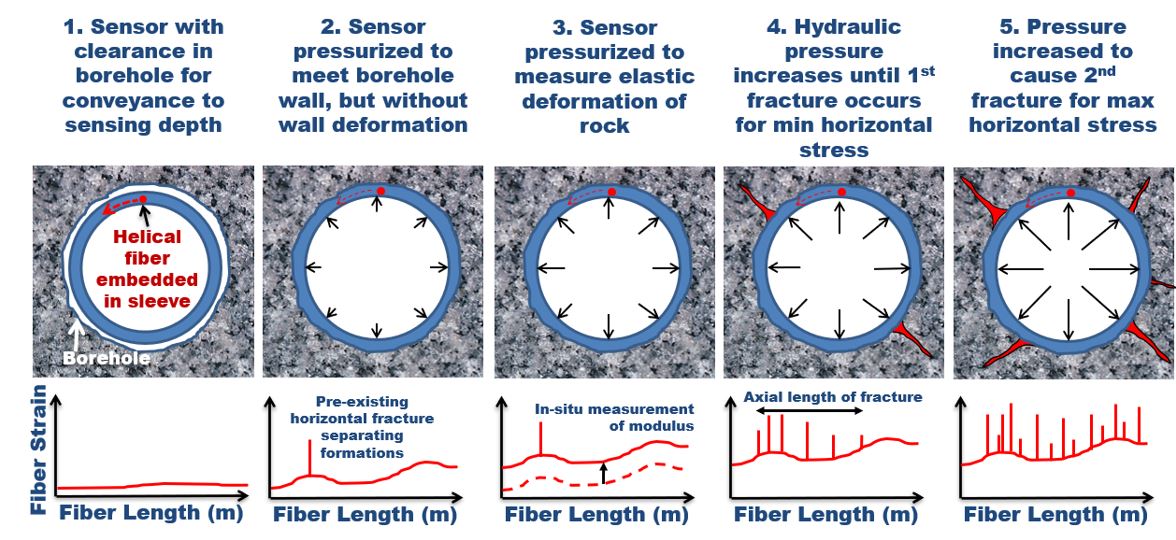
Methodology of Distributed Fiber Optic Sleeve Concept
- Place sensor uninflated at the desired depth. This allows for sufficient clearance to position it within the borehole.
- Pressurize the sensor sleeve until it expands radially to conform to and interface with the contours of the borehole wall. A strain measurement is acquired here and becomes the baseline signature against which measurements taken at higher pressures will be compared. The baseline measurement may also give information on the variation in shape of the borehole versus depth and the existence of pre-existing fractures. A horizontal fracture will manifest as a single peak in the strain measurement along the helical sensor path.
- Increase the hydraulic pressure within the sensor to create elastic deformation of the rock wall so measurements of the elastic modulus can be made. This measurement could identify changes in modulus (due to varying materials) as a function of depth as well as the porosity of the borehole wall identified by localized strain profiles.
- Increase the hydraulic pressure to the point that the first fracture occurs. In theory, the direction of this fracture should be perpendicular to the minimum horizontal stress, Sh. The measured strain will exhibit a pattern of periodic peaks due to the helical configuration of the fiber in the sleeve; it will intersect the fracture on multiple windings. The distance of the first peak from the sensor origin will indicate at which angular orientation the first fracture occurred, assuming that the orientation of the sensor to an absolute reference frame is known. The axial length of the fracture down the borehole can be determined from the number of peaks observed and their relative distance down the fiber. An additional benefit of this as compared with traditional fracturing techniques is that the fractures are observed immediately during the pressurization process rather than using an impression packer or visual post-process.
- Increase pressure until a second fracture occurs, which relates to the maximum horizontal stress, SH. The relative clocking direction of this secondary fracture can be calculated from the phase between the first series of peaks and the new series of peaks. The measurement technique can accommodate additional unintended fractures or non-perpendicular fracture directions because the high-resolution strain data will resolve these features. Variations in fracture magnitude and angular orientation, which corresponds to in-situ stress, may change along the depth of the borehole, and the proposed technique would allow those variations to be observed with high resolution. The resulting stress versus depth that is calculated from the technique would be plotted as seen in Figure 1.
After executing a complete measurement at a single location, the pressure in the sensor sleeve is reduced. The fractures will close, and the sleeve is free to be positioned at the next location. During this process, all hydraulic fluid remains contained within the sensor. Because no fluid is lost and the outer diameter of the sensor sleeve can be as small as 66 mm, it is anticipated that all the equipment necessary to perform a measurement will fit on a utility truck (hydraulic pump, a spool of sensor/cable, reservoir of fluid, instrument electronics, and computer).
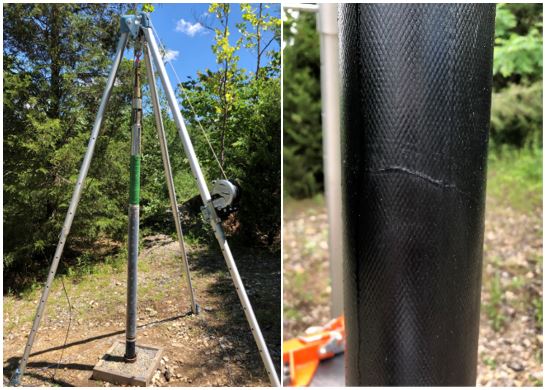
CHISL Proof-of-Concept Experiments
A shallow HQ borehole was drilled at a local limestone quarry to demonstrate the fracture-sensing capability of the CHISL prototype (Figure 3). The tensile strength of the rock was determined to be 3,100 psi using Brazilian disc tests of core samples.
An impression packer was used before and after CHISL operation to verify the fracture state pre- and post-test. In the measurement described here, a pre-existing horizontal fracture was the only impression recorded before the test.
As the CHISL assembly was inflated, this same horizontal fracture was visible in the strain map of the borehole wall, as seen in Figure 4. The x-axis of the plot is along the depth of the hole, while the y-axis is the polar angle around the circumference of the cylindrical CHISL sensor. The color map indicates the strain level observed at every location within the embedded fiber optic sensor.
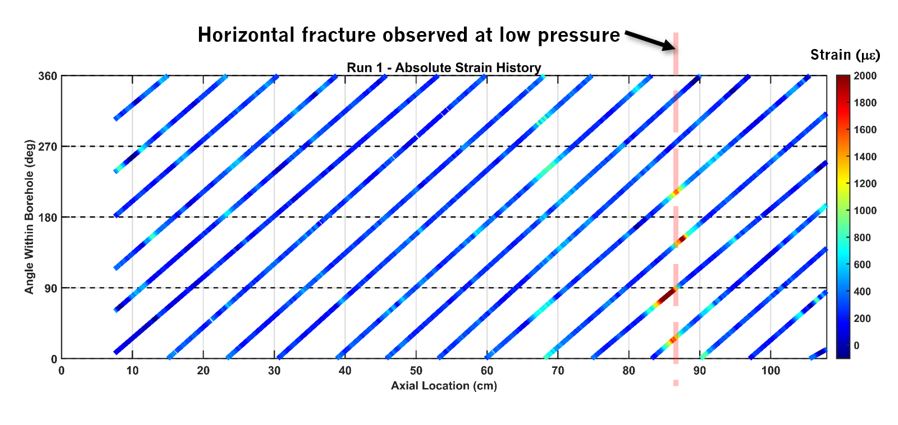
Further pressurizing the CHISL sensor, bi-wing fractures appeared below and above the horizontal fracture, but at different angles and at different pressure applied to the borehole wall, as seen in Figure 5.
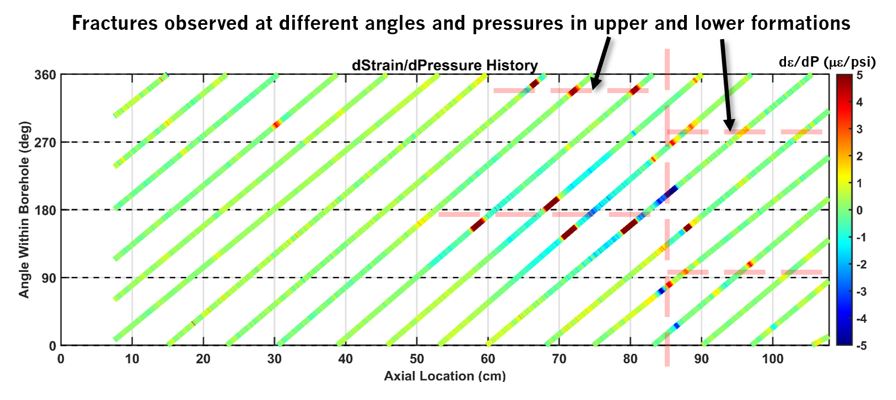
The color map in this plot represents the derivative of strain with respect to pressure increase and is helpful in identifying rapidly growing locations of strain as pressure is ramped. Below the horizontal partition the fractures occurred at 90° and 270° at a lower pressure of 2,500 psi, while the formation above the horizontal partition fractured at 180° and 330° at a pressure of 3,700 psi. This demonstrates the power of the distributed sensing concept. Within the 1 m sensing region there is sufficient spatial resolution to detect individual fractures opening, their length, and changes in stress orientation along the depth of the hole, and even measure two distinct formations simultaneously.
The borehole was further pressurized with the CHISL sensor until a double fracture occurred at 4,900 psi, seen in Figure 6. The new fracture at 270° is roughly 90° between the bi-wing fracture that originated at the lower pressure. It is also observed that the fracture at 330° decreases while a new longer fracture at 0° opens. According to theory, this new fracture is related to the maximum in-situ stress in the rock formation.
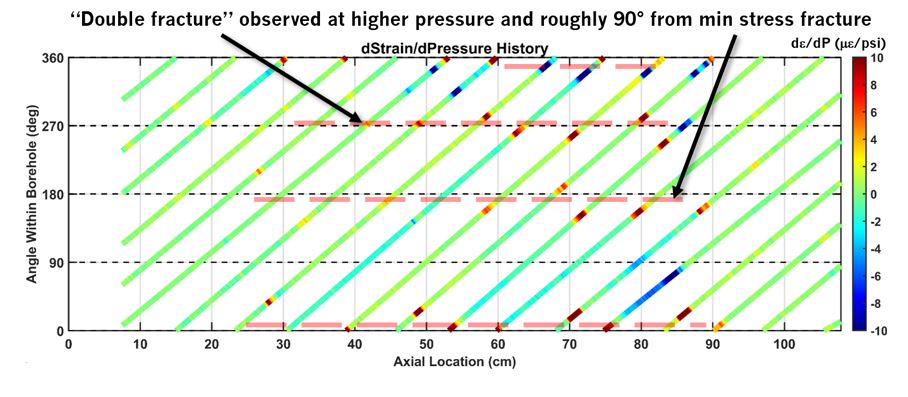
Relating these local measurements to the far-field stress state is the next critical step, and Luna’s team of partners has developed an algorithm to calculate the far-field stress state from the high-definition fiber optic sensor data. Visualizing these fracture evolutions with such spatial resolution and in real-time is unprecedented.
This experiment proves that the CHISL sensor has the potential to create, measure, and visualize both fractures corresponding to minimum and maximum horizontal stress. When deployed, this technique would provide critical measurements with unmatched consistency and depth resolution, allowing safer and more efficient well operations.
The Shell GameChanger™ program works with companies to deliver high-impact energy technology through collaboration various companies. For more than 20 years, it has helped numerous startups to get the funding and expert support they need to grow. In recent years, GameChanger™ has strategically focused on technology development that speeds up Shell’s energy transition effort, including forming strategic alliances with various incubators, academic institutions and national laboratories.
Read the news release on the CHISL sensor or contact Luna for more information.